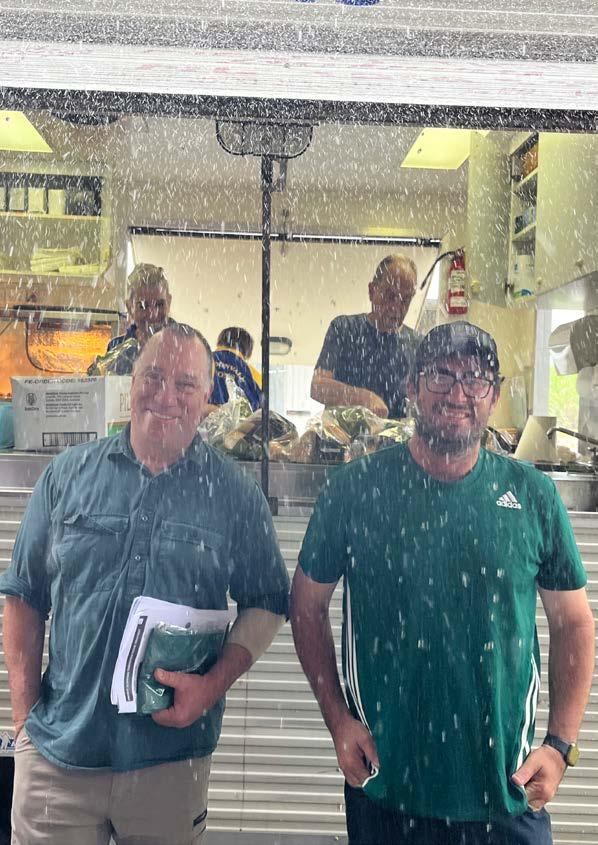
30 minute read
Strategic Pillar 3 – Translation expertise
Translate research findings into tools, products and services that save industry time and money, and improve environmental performance
New service delivery model
Advertisement
SRA’s new service delivery model, outlined in the strategic plan is focused on three key objectives: developing a deep understanding of industry’s profitability, productivity and sustainability drivers
making it easy for industry to extract value from research
working with and through the industry’s local extension providers. Over the past year, in implementing the new model, SRA has worked to engage at the grassroots; translate, adapt and develop complex science and technology into a compelling product and service offering relevant at a local level; and distribute tools, products, services and scientific expertise to local extension providers.
Feedback from industry
SRA commissioned grower and miller surveys through an independent provider during the final quarter of 2021/22. Questions sought to understand respondents’ views about progress towards outcomes in the 2021 – 2026 strategic plan, and to obtain actionable insights to support improvement. The surveys examined a range of topics including sentiment, connection with organisational goals, perceptions about SRA’s research portfolio and products, district engagement, communication needs and experiences and views on the plant breeding program and new varieties.
High-level survey outcomes are shared in this annual report and through SRA communications and engagement, and improvement action plans will be developed and shared with growers and millers during the first half of 2022/23.
Grower insights
The grower survey collected insights from 250 levy-paying sugarcane growers who are members of SRA. Feedback was obtained through a combination of online surveys and phone interviews, through independent survey provider, Intuitive Solutions. A summary of overall feedback follows.
Satisfaction
How satisfied are you that your research and development levy is being invested to achieve the outcomes you expect?
Advocacy
How likely is it that you would recommend the services, products and information SRA provides to other growers or industry associates?
0
Not at all satisfied
6.2
10
Extremely satisfied 0
Not at all likely
Satisfaction with key grower touchpoints
6.5
10
Extremely likely
District Manager* Researchers* Products & Services*
6.0 6.0 7.1
Plant Breeding Program*
Quality of Communications*
6.8 7.0
*The average satisfaction score for each topic is a rating from 0 (extremely dissatisfied) to 10 (extremely satisfied).
Miller insights
Survey responses were received from 23 representatives across eight of the nine milling companies in the industry. Feedback was obtained through a combination of online surveys and phone interviews, through independent survey provider, Intuitive Solutions. This is a summary of their feedback. Milling company averages are reported for companies where more than one respondent provided feedback.
Satisfaction
How satisfied are you that your research and development levy is being invested to achieve the outcomes you expect?
Advocacy
How likely is it that you would recommend the services, products and information SRA provides to other growers or industry associates?
0
Not at all satisfied
5.6
10
Extremely satisfied 0
Not at all likely
Satisfaction with key miller touchpoints
6.6
10
Extremely likely
District Manager* Researchers* Products & Services*
6.2 7.0 7.5
Plant Breeding Program*
Quality of Communications*
7.1 7.0
*The average satisfaction score for each topic is a rating from 0 (extremely dissatisfied) to 10 (extremely satisfied). Millers on average reported overall satisfaction with research and development levy investment of 5.6 (on a scale of 0-10, where 0 represents extremely dissatisfied and 10 extremely satisfied). This result suggests moderate satisfaction with SRA.
Advocacy of SRA by millers is higher with an average company result of 6.6 on the same scale. Put differently, seven of the eight participating companies report some level of positive advocacy for SRA’s products, services and information.
There was a strong statement from millers about their confidence for the future of the Australian sugarcane industry over the next 12 months. Almost all millers reported being confident (94 per cent), with just a very small number holding a more pessimistic outlook. Millers provide a range of satisfaction ratings for key touchpoints with SRA (from 6.2 to 7.5 on a 10-point scale) suggesting they attach different value to each of the various offerings by SRA. Millers typically report higher satisfaction with SRA’s products and services, variety development program, and research portfolio. However, respondents rate lower satisfaction with ‘people’ touchpoints such as their experience with SRA district managers (rating 6.2) on the same scale. Like growers, millers support of SRA’s industry and research plans is dependent on their awareness of and familiarity with the plans. Respondents rated on average higher familiarity and satisfaction with these plans than growers.
MERINGA
TULLY FAR NORTH
INGHAM
BRANDON HERBERT
BURDEKIN
MACKAY CENTRAL
9
LOCATIONS
SOUTHERN
BUNDABERG
WOODFORD
INDOOROOPILLY
BROADWATER District manager model
Across each of our five districts, district managers work with local industry and services providers to identify improvement opportunities and develop local productivity plans. SRA district managers provide a direct touch point in each district to build a deep understanding of the challenges and constraints that industry faces in their local area. The district manager approach seeks to strengthen industry collaboration, moving beyond drawing on industry as interviewees or subjects of research, and involving them as equals in the co-creation of strategies in the local area.
The first year under the district manager model has seen development of local productivity plans for each district and an increased focus on managing relationships with local productivity services providers for extension support and connecting industry with researchers. During 2021/22 the district manager model operated based on the following districts:
Far North
Mossman, Mulgrave, Tableland and South Johnstone growing and mill areas District Manager – Gavin Rodman
Herbert
Victoria and Macknade growing and mill areas District Manager – Phil Patane
Burdekin
Invicta, Pioneer, Kalamia and Inkerman growing and mill areas District Manager – Terry Granshaw
Central
Proserpine, Farleigh, Marian, Racecourse and Plane Creek growing and mill areas District Manager – Dylan Wedel
Southern
Millaquin, Isis Central, Rocky Point, Condong, Broadwater and Harwood growing and mill areas
District Manager – Lisa Devereaux
Far North
In the Far North, the district plan encompasses three broad categories designed to address key constraints: understanding key agronomic drivers for productivity improvement based on local practices and systems reducing the impact of ratoon stunting disease (RSD) and other diseases improving commercial cane sugar (CCS) at harvest.
By identifying constraints to productivity at the mill, farm and block levels, strategies can be developed and implemented to improve their management.
Local Expert Analysis
Work being undertaken includes local expert analysis (LEA) in the Tully and South Johnstone areas in collaboration with local industry. At Tully, following data collection and review, key findings were presented and opportunities identified to refine management practices. Working groups involving SRA and influential, leading growers have further examined pests, weeds and diseases; agronomy; crop maturity; harvesting and data. Key findings have been shared with industry, and an action plan recommended. In South Johnstone, data analysis is ongoing. Initial interviews and sampling with competent and significant growers confirmed lower than expected productivity. Pachymetra root rot, ratoon stunting disease, nutrient deficiencies and soil acidity are among issues identified. There remains significant potential to improve productivity in the district through continued focus and partnering on the LEA.
Mobilising the Murray Reef Trust VII (MRT 7)
SRA is a partner in Mobilising the Murray Reef Trust VII (MRT7) project which is supporting farmers to address productivity constraints and access incentives. SRA has recruited two agronomists, who are working exclusively on the project, to support growers in identifying constraining issues on farm such as soil health, disease and pests, drainage management, nutrient management and low yielding blocks.
Other work includes:
soil specific management for sugarcane production in the Wet Tropics (National Landcare Program Smart Farms
Small Grants funded) developing management strategies for emerging and troublesome weeds - navua sedge, itch grass and balsam pear.
Dr Danielle Skocaj and Dr Rob Magarey inspect Joe Zappala’s plant cane crop in South Johnstone.
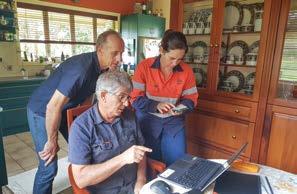
Dr Rob Magarey and Dr Danielle Skocaj review Joe Zappala’s productivity performance history.
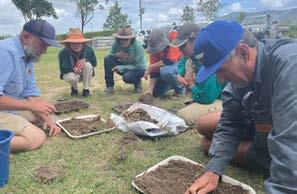
Reducing the impact of RSD, and other diseases
Initiatives include a collaborative review of the Innisfail Babinda Cane Productivity Services’ Clean Seed Plot and development of an Upgrade Roadmap, with support and development where appropriate for local variety management groups.
Improving CCS at harvest
By measuring and monitoring crop maturity, management strategies such as use of crop ripeners may offer opportunities to improve CCS at harvest. A highlight of this work has been the creation of eleven trial sites across the Tableland, Mulgrave and South Johnstone mill areas to develop a set of parameters for moisture in cane to support a repeatable result through the expanded use of Moddus® for CCS management. MSF Sugar’s Tableland Cane Supply and Logistics team are supporting this work with a collaborative $49,850 of economic activity to date. The tactical use of ripeners is seen as an opportunity to improve early season CCS in the Southern Tableland, leading to improved harvest logistics throughout the season. Currently, cane is not harvested until later in the season on the Southern Tableland, which is also the longest haul for cane to the mill.
Engagement
214 engagements recorded in Far North Queensland This includes:
104 engagements related to plant breeding 62 engagements related to district managers and activities 48 engagements related to translational research projects and activities Key engagement types: 125 meetings including individual, phone and group 56 farm visits
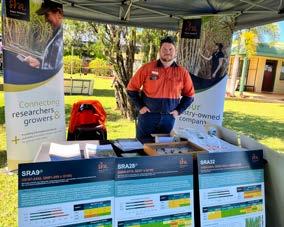
District Manager Gavin Rodman during an engagement event.
33 workshops, field days, shed meetings and on farm demonstrations
Stakeholders engaged in 2021/22 Engagements included 759 stakeholders Key stakeholder groups engaged with: 41% growers 19% prod services 17% milling companies 8% other industry organisations 10% industry representative organisations Note: South Johnstone and Tully have now been assigned to a revised North Queensland district along with Herbert; counts are not distinct and it is possible some stakeholders have been engaged, and therefore counted, multiple times.
SRA’s Laura MacGillycuddy speaks with industry representatives at the Meringa Field Day.
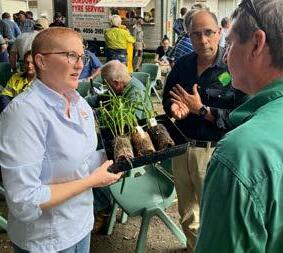
Herbert
A stakeholder engagement process in the Herbert district identified four district constraints to be addressed under the local district plan. Across each constraint area, a key focus has been improving dissemination of research knowledge through targeted and timely communication products, training packages and demonstration activities.
Other activities are outlined below.
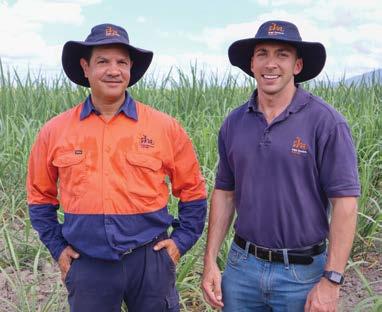
Herbert Variety Officer Juan Briceno and District Manager Phil Patane at the Herbert variety demonstration plot.
Variety development, selection and adoption
At the local level, variety demonstration plots are being implemented throughout the district, including an open day offering a variety demonstration plot walk-through in conjunction with release of the variety guide.
RSD measurement and management
District level mill assessment is being undertaken using the RSD LAMP Assay test (building upon a research initiative undertaken during the previous financial year. SRA is assisting in the automation and implementation of the test in the Herbert district.
Improved adoption of new technologies
Development and imminent release of an SRA and Department of Agriculture and Fisheries harvest decision support tool was a specific focus during the year, along with field days designed to increase awareness and adoption of yield and cane loss monitors locally. A review was also undertaken of the harvester front end with a view to improve ratoonability following harvest.
Sound agronomic practices
Improved agronomic practice focused on a range of activities, including: continuation of nitrogen product formulation demonstration trial
continuation of SIX EASY STEPS® validation trial in the drier climate zone
validating nitrogen (and phosphorous) rates on very high yielding blocks refining nutrient recommendations following application of subsurface banded mill by-products to manage the effect on yield and CCS development of nutrient management and soil health tools.
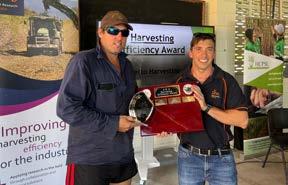
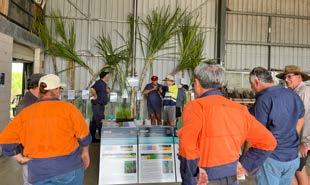
Variety Development Manager Herbert Dr Fengduo Hu discusses varieties with an attendee at the Herbert Field Day.
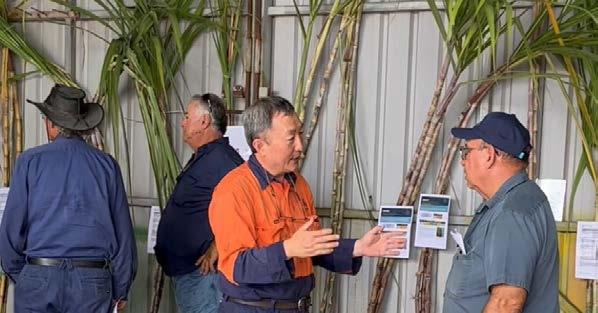
Engagement
More than 50 people attended the Herbert field day in May, including 36 growers not previously recorded as attending an SRA event. The farmers who attended accounted for more than 20 per cent of the local growing district. Positive feedback suggested that presentations were topical and addressed the key district constraints with good opportunities to ask questions and workshop the topics. 84 engagements recorded in North Queensland (including Herbert in 2021/22). This includes: 31 engagements related to plant breeding 52 engagements related to district managers and activities
1 engagement related to translational research projects and activities Key engagement types: 40 meetings including individual, phone and group 26 farm visits
18 workshops, field days, shed meetings and on farm demonstrations Engagements included 577 stakeholders Key stakeholder groups engaged with: 35% growers 19% prod services 13% milling companies 7% government 24% industry representative organisations Note: South Johnstone and Tully have now been assigned to a revised North Queensland district along with Herbert. Counts are not distinct and it is possible some stakeholders have been engaged, and therefore counted, multiple times.
Burdekin
The Burdekin district plan identifies four constraints that are being addressed at the local level: irrigation variety management soil health
pests and diseases.
Irrigation
Expressions of interest were received for the Burdekin Irrigation Project from 70 farmers, accounting for 7000 hectares of farming land. To date, full automation of furrow irrigation has been installed on 2000 hectares of land achieving water and energy savings for growers, along with environmental benefits.
Twenty-four presentations about the Burdekin Irrigation Project reached more than 250 growers at shed meetings.
Variety management
Through shed meetings and one-on-one meetings, SRA and Burdekin Productivity Services have partnered to educate growers on the importance of clean seed. Demonstration walks with groups of farmers and cane grower collectives showcased the local variety program. Tissue culture was purchased by two growers in the district for the first time, with further interest received for the coming 12 months. SRA worked with productivity boards and mills to understand estimated CCS levels prior to the commencement of the crushing season. Future work will examine use of growth regulators.
Soil health
SRA collaborated with the Department of Agriculture and Fisheries to deliver a series of successful soil health presentations. SRA provided advice on ground preparation for mixed species crops, which in the past have had limited uptake in the district due to irrigation costs. Meetings were also conducted about increasing fallow land to soybeans to meet market demand. A phosphorous (P) trial undertaken on a Wilmar farm has been converted to a research trial and will provide a good understanding for the local district of P application and yield response.
Australian Cane Farms Farm Hand Duppie Cornel programs the irrigation schedule for the farm.
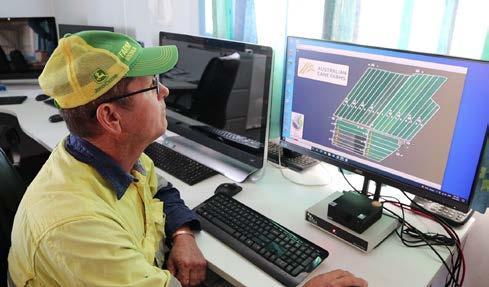
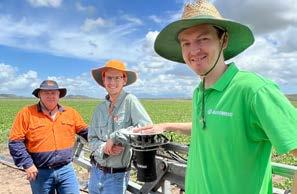
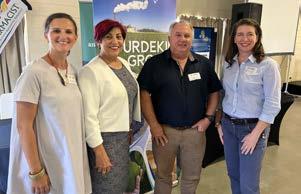
District Manager Burdekin Terry Granshaw with AutoWeed Technical Officer Jake Wood and AutoWeed Managing Director Dr Alex Olsen in the field during a robotic spray trial on a legume crop. District Manager Terry Granshaw with Townsville Enterprise Chief Executive Officer Claudia Brumme-Smith, Burdekin Shire Mayor Lyn McLaughlin and Senator Susan McDonald at Farming in Focus.
Pests and diseases
An educational workshop was delivered on ratoon stunting disease and the LAMP assay project undertaken in the Herbert was the subject of a workshop with growers. Discussions at shed meetings also addressed the RSD project in the Herbert and how the Burdekin would support it. Talks with DAF examined land to trial RSD infected cane and RSD free cane to measure yield loss under an irrigated system. Soil samples were collected for analysis of a new nematode, never before found in sugarcane in Australia. Collections of greyback cane beetles and canegrubs were provided for breeding to support research into alternative management treatments. District communications warned of the potential for higher-than-normal infestations of canegrubs. Discussions about AutoWeed spot spraying trials were a highlight at shed meetings throughout the year, attracting strong interest and support from growers.
Harvesting
As part of a focus to increase yield and profitability through the adoption of new harvesting technology, a cane loss monitor was installed on a Burdekin harvester. The monitor enables trials on loss monitoring in a burnt cane system.
Engagement
291 engagements recorded in the Burdekin. This includes: 267 engagements related to district managers and activities
24 engagements related to translational research projects and activities Key engagement types: 118 meetings including individual, phone and group 69 farm visits
53 project activities 46 workshops, field days, shed meetings and on farm demonstrations
5 other activities
Engagements included 1214 stakeholders Key stakeholder groups engaged with: 34% growers 20% prod services 5% milling companies 9% other industry organisations 8% government 6% industry representative organisations Note: Counts are not distinct and it is possible some stakeholders have been engaged, and therefore counted, multiple times.
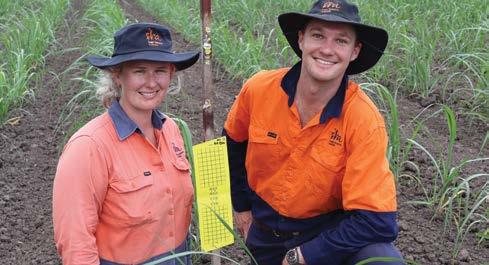
District Delivery Officer Stephanie Duncan and District Manager Dylan Wedel with sticky traps at a Mackay farm. The traps monitor the presence of insects and mites in an effort to learn more about yellow canopy syndrome.
Central
The Central district plan and work with industry during the year focused on several key issues: variety adoption irrigation utilisation good farm practices through addressing pests/diseases.
Variety adoption
SRA collaborated with local productivity services companies to collect observations on recently and soon to be released varieties growing across 12 sites in the district.
Irrigation utilisation
The team undertook an irrigation survey and on farm irrigation audits to identify opportunities for improvement. A number of studies were collated to form a submission to the 24th International Commission on Irrigation and Drainage (ICID) International Congress and Irrigation Australia Conference.
Addressing pests and diseases
SRA provided growers with an opportunity to see under ultraviolet light the less than adequate application of imidacloprid which may have contributed to the crop damage from pests seen in the district this year. A demonstration at shed meetings highlighted the impact of Pachymetra root rot on a susceptible variety compared with a resistant variety. Monitoring was established at four sites for insect populations believed to be linked to yellow canopy syndrome (YCS). Team members and growers collected hundreds of greyback cane beetles to support a research project.
Professional development
Another focus was working with local productivity officers to offer professional development across a range of topics to support their recommendations to local growers to improve farming practices. Topics included: soil health extension tool kit
in-field sucrose loss measurement – harvest loss assessment
in-field identification of visible diseases
managing fallow crops in the region ratoon stunting disease – research and the importance of farm hygiene legislation for N and P budgeting SIX EASY STEPS® - incorporating all aspects of nutrient management and the soil and resulting crop Farm Economic Assessment Tool Online (facilitated by
Queensland Department of Agriculture and Fisheries) optimising fertiliser recommendations given high input costs
weed management – including weed identification and pre-emergent herbicides.
Engagement
SRA’s district team engaged with more than 300 growers across the region during collaborative shed meetings, providing updates on SRA activities and answering questions. Field days undertaken in Proserpine and Mackay in collaboration with local productivity organisations were also an opportunity for around 220 growers to interact with SRA’s plant breeding staff, translation researchers and other groups working on productivity/profitability improvement projects in the region. The Proserpine Ag Tech Field Day was the main event for the Proserpine Young Growers group and was supported in collaboration with Sugar Services Proserpine. The Mackay and Plane Creek Area Young Growers group was launched in early 2022. Through this group, SRA is supporting young growers to build their knowledge and share information to nurture the next generation of the industry. 102 engagements recorded in Central. This includes: 51 engagements related to plant breeding 40 engagements related to district managers and activities 11 engagements related to translational research projects and activities and other events. Key engagement types: 53 meetings including individual, phone and group 3 farm visits
3 project activities 38 workshops, field days, shed meetings and on farm demonstrations
5 other activities
Engagements included 1183 stakeholders
Key stakeholder groups engaged with:
42% growers 27% prod services 14% milling companies 5% government. Note: Counts are not distinct and it is possible some stakeholders have been engaged, and therefore counted, multiple times.
Weed scientist Emilie Fillols discusses weed management during a professional development program for productivity services providers in Mackay. Variety Development Manager George Piperidis talks about varieties at the Mackay field day.
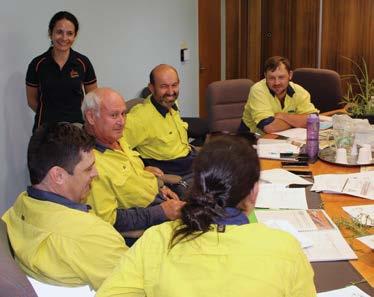
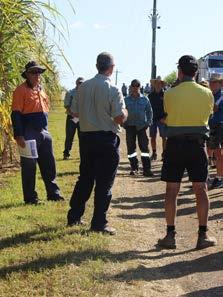
Southern
The Southern district covers sugarcane production areas spanning more than 800 kilometres from north to south, across three distinct geographies: Bundaberg/Wide Bay (supplementary irrigation and rainfed) Rocky Point (rainfed) Northern New South Wales (rainfed).
The most significant challenge identified in the district plan is maintaining individual farm and mill viability in the face of rising input costs and competition for land use. Environmentally, the region has also needed to adapt and respond to significant weather events, from periods of drought in recent years to this year’s severe flooding. In addition, irrigation and energy efficiencies, pest and disease management and soil health are forefront on the list of significant issues in the district. In addition to local events held during the year, service agreements were negotiated with Northern NSW and Rocky Point cane growing districts to fund projects aligned with their local priorities.
Bundaberg/Wide Bay
In conjunction with the Department of Agriculture and Fisheries, SRA provided a regional report of the Southern Sugar Solutions project, a novel program that linked research, development and extension activities, to Bundaberg, Isis and Maryborough. New activity during 2022/23 will be the launch of a local expert analysis (LEA) program in the region.
Rocky Point
In Rocky Point, efforts focused on a plan to improve farming systems, nutrient management, varieties and disease management (specifically ratoon stunting disease). A collaborative event schedule was planned for researchers to deliver workshops and seminars on key priority areas. In addition, SRA funding supported an agronomist who worked under contract with all growers to prepare productivity plans customised for their farms. A third workshop was held on soil nutrition and results from the SIX EASY STEPS® trials at Rocky Point.
Northern New South Wales
In Northern NSW, SRA has provided industry support through New South Wales Agriculture Services and Sunshine Sugar. Through a service agreement, SRA seeks to fund projects aligned with the priorities of the AgServices Strategic Plan (2021-2033). Unfortunately, engagement with NSW was hampered by COVID restrictions for the first six months of the year and then flooding in the region. Although COVID restrictions have now eased, the impact of floods on growers’ farms and mill areas will continue to affect the area for the remainder of the year. One project has been approved for maximising returns through efforts to decrease harvesting losses.
SRA’s Barry Salter and District Manager Southern Lisa Devereaux with Neil Halpin from Queensland Department of Agriculture and Fisheries during a workshop at Bundaberg.
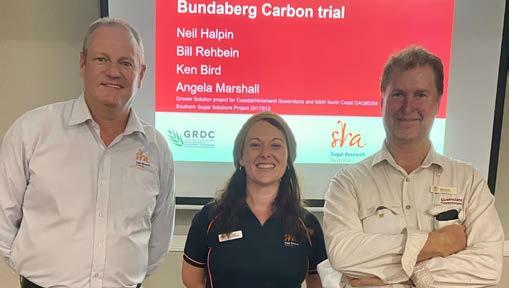
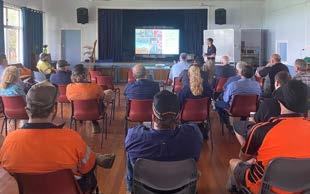
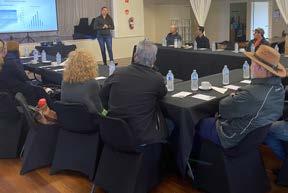
SRA’s Phil Patane discusses Harvest Best Practice during a workshop at Rocky Point. Pathology Senior Technician Lucy Gibbs addresses a grower workshop at Rocky Point, explaining how cane samples are analysed in the lab for ratoon stunting disease.
Engagement
Key activities have focused on increasing industry engagement by delivering targeted workshops and seminars with SRA researchers on latest research and trial outcomes from the priority areas that interest growers. Although there were some travel restrictions due to COVID, several face-to-face workshops were undertaken to coincide with consultation sessions on the district plan. The team delivered a demonstration of the Soil Health Toolkit, three Harvest Best Practice workshops and two seminars on the local incidence of RSD, while sharing updates on the diagnostic methods currently in trials. Events were well attended, and positive feedback was received.
52 engagements recorded in Southern including NSW &
Rocky Point. This includes: 33 engagements related to plant breeding 17 engagements related to district managers and activities
2 engagements related to translational research projects and activities and other events Key engagement types: 28 meetings including individual, phone and group 9 farm visits
3 project activities 11 workshops, field days, shed meetings, and on farm demonstrations
3 other activities
Engagements included 484 stakeholders Key stakeholder groups engaged with: 34% growers 27% prod services 18% milling companies 10% industry representative organisations. Note: counts are not distinct and it is possible some stakeholders have been engaged, and therefore counted, multiple times.
Other events and sponsorships
In addition to work under the district plans, SRA supported and participated in a range of events across sugarcane growing regions and communities.
Regional Milling Research Seminars
Approximately 100 milling representatives attended this year's Milling Regional Research Seminars, jointly presented by Queensland University of Technology and SRA during March.
Sessions were conducted at Gordonvale, Townsville, Mackay, Bundaberg and Rocky Point, with representatives of the New South Wales industry joining the Rocky Point event through a virtual video link.
The sessions provided an update on milling research undertaken over the past 12 months.
ASSCT Conference
SRA was a gold sponsor and exhibitor at the Australian Society of Sugar Cane Technologists’ (ASSCT) conference held in Mackay in April, with the theme of Future proofing a resilient industry. The three-day event included an exhibition, conference program and tours, showcasing the latest in research and development from across the industry. The conference is the flagship event of ASSCT, an association of scientists, technologists, growers, millers, managers, institutions and companies concerned with the technical advancement and sustainability of the Australian sugarcane industry. Attendance at this year’s event was 65 per cent higher than at the 2021 conference in Bundaberg, and the largest attendance since the 2003 conference held in Townsville.
Multiple papers and presentations at the conference related to research by SRA employees and initiatives funded by SRA.
Part of our communities
SRA is part of the communities in which it operates, and wherever possible is involved in community events aligned with its operations, and in supporting local volunteering groups. Examples during 2021/22 include exhibiting at the Gordonvale Sugar Solstice, participation at regional shows and engaging with community groups to support their fundraising during our field days.
SRA’s Andrew Lynch, QUT’s Geoff Kent and Wilmar’s Jay Venning and Russell Kirk at the Townsville seminar.
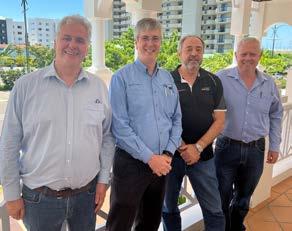
The Townsville Milling Regional Research Seminar drew strong attendance.
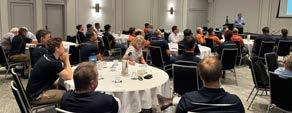
SRA’s Barry Salter, Emilie Fillols and Julian Connellan were among presenters at ASSCT. SRA’s booth at ASSCT. Nicole Thompson accepts an award at ASSCT from Ross Broadfoot.
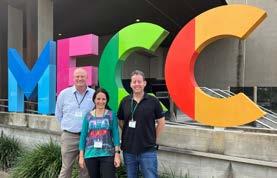
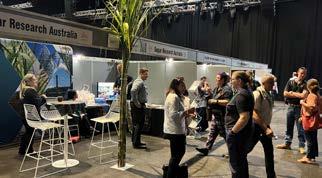
Translate, adapt and develop
Laboratory screening services
SRA houses several internal laboratories that provide analytical and diagnostic services and support to SRA-led projects, industry partners and external clients. Facilities at Indooroopilly offer chemical analytical services (chemical laboratory) and molecular diagnostic services (molecular diagnostics laboratory) for various sugarcane diseases, including ratoon stunting disease. The chemistry laboratory provides a suite of services to analyse the composition of soil, plant tissue, water, byproducts and other samples. The lab primarily services SRAled research projects, but also supports external customers with measurement of micro and macro nutrients and near infrared (NIR) calibration development. The chemistry team also provides specialist tests and method development
Laboratory Analysis type
Nutrients
Chemistry Laboratory Residues
Sugarcane quality Molecular Diagnostics Laboratory Near infrared Ratoon stunting disease
Soil Laboratory Pachymetra Nematodes
Total Samples/Assays Pachymetra & nematodes capabilities, such as environmental analysis of chemical residues and their breakdown products, and supports SRA’s sugarcane breeding program by conducting quality screening analysis of advanced clones. While the chemistry laboratory was severely affected by the rain event of early 2022 and some areas had to be shut down for a period of time, the team delivered on the majority of project requirements and made notable contributions towards research and development activities. The Tully station also has a diagnostics soil laboratory that specifically assays for Pachymetra root rot and nematodes. During 2021/22, SRA received more than 18,500 samples, completing just under 29,800 assays or tests.
Samples
2,687 165
1,516
315
13,038 669
34
109
18,533
Assays
7,745 5,610 1,516
949
13,038
778
143
na
29,779
Among the highlights for the laboratory team during the year were:
A significant amount of method development was undertaken in both the
NIR and residue areas. Soils were scanned and preliminary NIR models developed to measure various nutrients in dried soils, fresh soils and in water samples. The data will support the feasibility of developing an infield soil/water analysis tool for the rapid, non-destructive measurement of nutrients for improved soil health management. SRA’s ability to conduct trace-level environmental screening for residues and their breakdown products was expanded to include the insecticide imidacloprid, up to 23 types of herbicide and 12 major metabolites of these compounds. The bespoke analyses were developed to support research and development in the areas of farm chemical management and best practice. The work supports the development of strategies to increase the retention of compounds on farm, reduce input costs, and monitor environmental impact to the Great Barrier Reef water catchments. Resistance screening protocols based on modern molecular methods were developed and a trial planned to screen 14 new varieties for resistance ratings. This work aims to fill an industry-driven call to bring back RSD “ratings”. The team assisted with the experimental and trial designs for a Griffith
University Australian Research Council Linkage project that aims to incorporate new sensor technologies from medical diagnostics to develop an integrated device for the rapid, on-farm detection of various sugarcane diseases.
Communications
SRA communicates with the industry through a range of print, digital and face-to-face to channels. The team develops and releases a quarterly magazine, fortnightly eNewsletter, multiple manuals and booklets including variety guides, and manages the website, social media channels, webinars and supports multiple face-toface events.
The number of face-to face events increased markedly during 2021/22 under the district manager model and easing of COVID-19 restrictions. Another change this year has been the creation of a new internal newsletter for SRA employees, Sugar Press. Sugar Press is released fortnightly and is designed to share important whole of business updates across SRA, reducing the number of emails in the business. It is released in alternate weeks to the industry-facing eNewsletter.
Cane Matters
This year, following consultation with industry representative groups, SRA merged the quarterly CaneConnection and bi-annual Milling Matters magazines to produce a new quarterly publication named, Cane Matters. While combining the titles of previous publications, the title represents a strong statement on the importance of the sugarcane industry to regional communities and economies – cane matters.
Insights suggest there is a ‘disconnect’ across the industry regarding the problems each part of the supply chain is trying to address, why those problems matter, and how SRA is contributing to the solutions through research. To address this, SRA needed to provide more effective and broader visibility of research across the supply chain. Cane Matters aims to support broader understanding of the challenges SRA's research is intending to address and make our communications more relevant to our levy payers. Cane Matters is also a platform to help change the narrative across the industry - to grow confidence and pride in the future, while being open about the realities and challenges our industry faces. Cane Matters is available as a print magazine for members and electronically for subscribers, or more recently, in an online flip magazine format. The vast majority of subscribers continue to receive Cane Matters in print format. While other industries are trending away from print publications, feedback suggests the majority of subscribers still wish to receive the magazine in hard copy format. While take-up of SRA’s electronic channels is growing, a proportion of growers report being unfamiliar with them. Among growers, awareness of, and satisfaction with key communications channels such as the SRA website, the Cane Matters magazine (previously Cane Connection and Milling Matters) and farming guides increased from previous survey periods. Satisfaction with face-to-face or online knowledge transfer events also rates highly among growers, millers and investors and partners.
100
% Growers Satisfied 80
60
40
20
0
Historical Satisfaction with Channels by Growers
2017
Website 2020
Year
Print publications 2022
Farming guides
Channel highlights
SRA regularly undertakes surveys of industry members to gauge satisfaction with services and communications channels and to identify improvement opportunities. Highlights include: grower satisfaction of 7.7 (out of 10) for Cane Matters feedback included: “top job on the new Cane Matters mag. It really profiles the contribution of your team and highlights the people behind the research. Good mix of content, too.”
Strategic Pillar 3: Outcome measures
Levy payers are satisfied with SRA products, services, and varieties
Target – 75% of levy payers satisfied by 2026 Result – For products and services: 87% of growers and 98% of millers, who were familiar with SRA services and products, report an average satisfaction rating in response to these. For varieties: 81% of growers and 92% of millers report an average satisfaction rating with SRA’s plant breeding program. Source: SRA Grower and Miller Surveys 2022
Growers have awareness of SRA’s research programs and outcomes
Target – 75% of growers by 2023 Result – 86% of growers report that they are very familiar or have some understanding of at least five research programs and outcomes. Source: SRA Grower and Miller Surveys 2022
Industry participants rate SRA as a trustworthy organisation
Target – 75% of industry participants rate SRA as trustworthy by 2026 Result – 76% of growers and 94% of millers report an average satisfaction rating in response to SRA staff being a trusted information source. Source: SRA Grower and Miller Surveys 2022
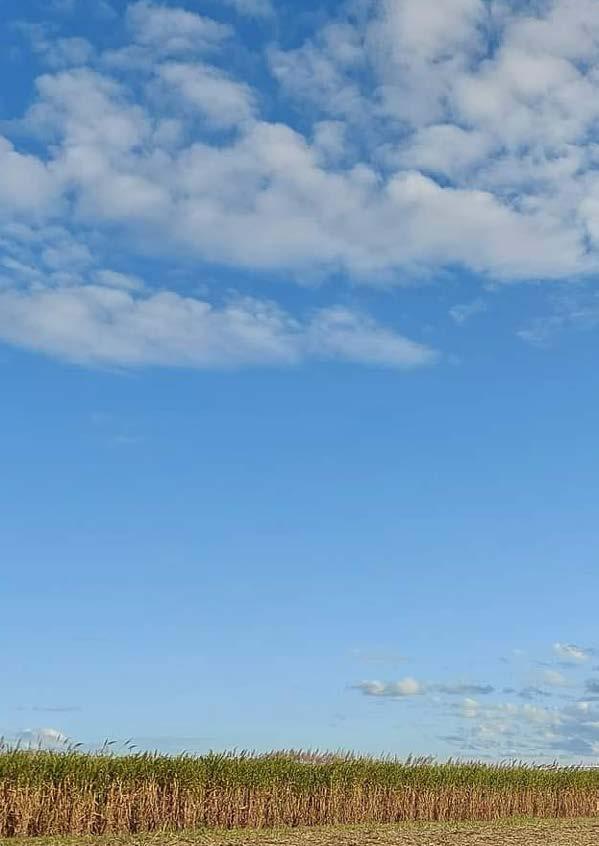
Impact of SRA’s industry services activities contribute to industry productivity gains
Target – Contribution to industry productivity gains of up to 10% per district by 2026 Result – It is not yet possible to report on this measure as SRA’s district productivity plans were only recently implemented. This measure will be reported in future annual reports.
Year-on-year expansion of self-service, digital and automated service delivery options to strengthen engagement and communication reach
Target – Year-on-year expansion of delivery options Result – In 2021/22, engagement with SRA’s digital and self-service products was as follows: QCANESelect®: 75% of growers and 58% of millers are familiar with the tool, and satisfaction by both groups is 7.3 on a scale of 0-10. SIX EASY STEPS®: 84% of growers and 66% of millers are familiar with the program, and satisfaction is 7.2 and 7.8 respectively on a scale of 0-10. Soil Health Toolbox: 56% of growers and 52% of millers are familiar with the tool, and satisfaction is 7.1 and 6.4 respectively on a scale of 0-10. Source: SRA Grower and Miller Surveys 2022
Calibration and screening services are cost neutral
Target – To be reported: Cost neutral by 2024 Result – The outcome will be measured when data becomes available and reported in SRA’s 2022/23 Annual Report.
Total commercial production is from new varieties
Target – 20% of commercial production is from new varieties by 2026 (average across districts) Result – ‘New varieties’ are those varieties within 7 years from the release decision by the Regional Variety Committee. Production of new varieties increased from 3.7% in 2020 to 5.4% in 2021.
Source: SRA








